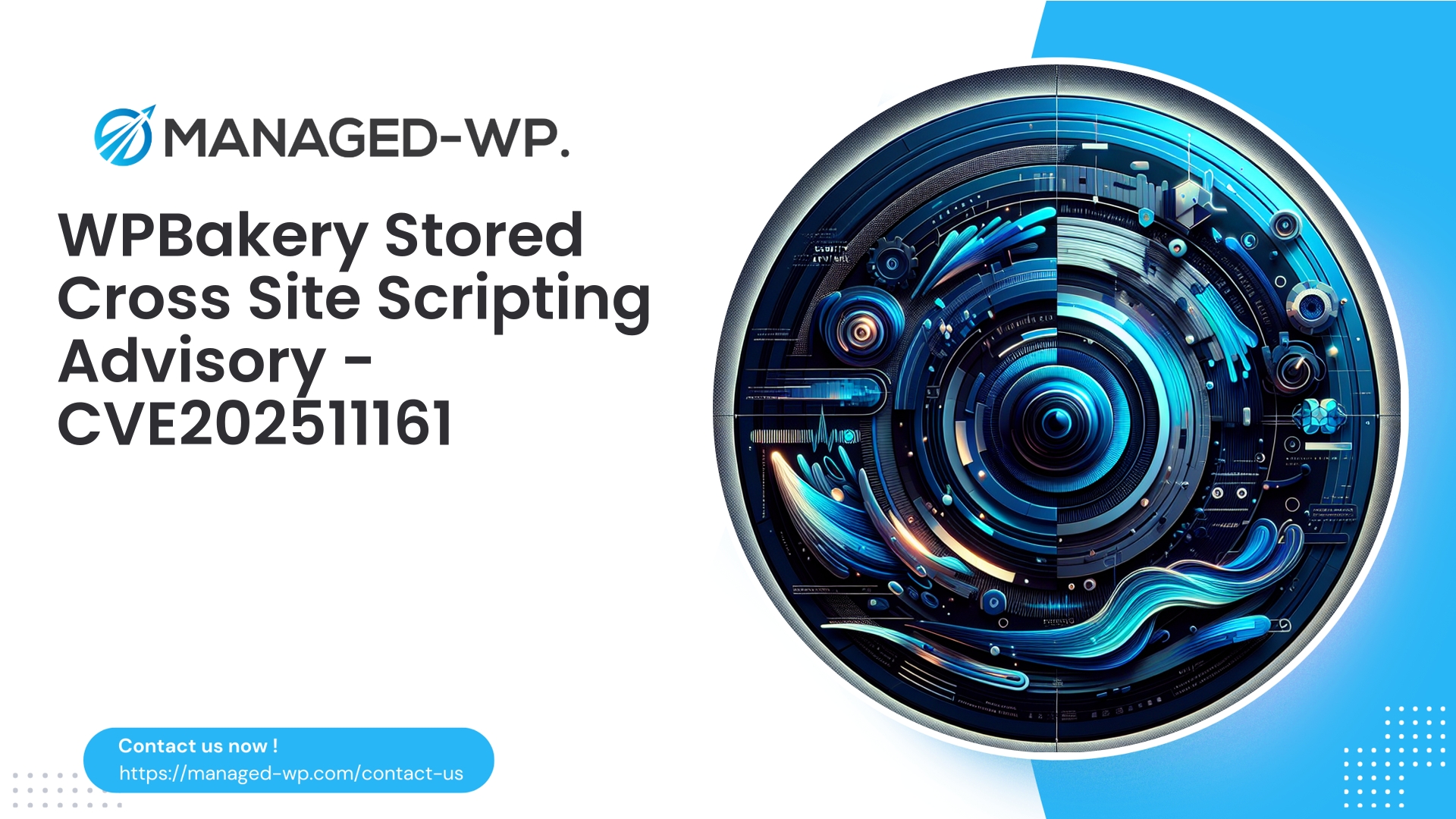| 插件名称 | WPBakery 页面构建器 |
|---|---|
| 漏洞类型 | 存储型XSS |
| CVE编号 | CVE-2025-11161 |
| 紧急 | 低的 |
| CVE 发布日期 | 2025-10-15 |
| 源网址 | CVE-2025-11161 |
WPBakery Page Builder <= 8.6.1 — 存在存储型 XSS 漏洞 vc_custom_heading 短代码(CVE-2025-11161):WordPress 网站所有者必须采取的措施
发布日期: 2025年10月15日
严重程度: CVSS 6.5(中等,低优先级补丁)
受影响版本: WPBakery Page Builder <= 8.6.1
补丁可用版本: 版本 8.7
CVE标识符: CVE-2025-11161
报道人: 独立安全研究员
作为一家总部位于美国的 WordPress 安全专家公司,Managed-WP 将为您带来一份简洁明了、通俗易懂的 WPBakery Page Builder 新漏洞分析。我们将阐述漏洞的本质、攻击者如何利用它、它在实际场景中构成的风险,以及您需要立即采取哪些措施来保护您的网站——无论您管理的是单个博客还是包含数百个博客的综合网站。
这种存储型跨站脚本(XSS)漏洞存在于…… vc_custom_heading 该漏洞利用短代码,允许拥有“贡献者”或更高发布权限的用户注入恶意脚本。这些脚本会被保存到数据库中,并在用户查看受感染内容时执行。此漏洞使网站访问者和管理员面临恶意 JavaScript 执行的风险,可能导致账户被盗用和网站遭到入侵。
这份深度报告包含以下内容:
- 对漏洞及其重要性做出清晰的解释
- 哪些人容易受到攻击?实际可行的攻击方法有哪些?
- 用于识别恶意或滥用内容的检测技术
- 立即采取保护措施和多层防御
- 检测到入侵事件时建议采取的事件响应措施
- Managed-WP 的先进解决方案如何帮助缓解此类威胁
本报告由经验丰富的网络安全专业人员撰写,重点关注可操作的防御和有效的补救措施。
执行摘要
- 该漏洞允许通过存储型跨站脚本攻击(XSS)。
vc_custom_heading由于输入清理不足,WPBakery Page Builder 8.6.1 及更早版本中的短代码存在问题。 - 厂商在 8.7 版本中发布了补丁;立即升级到此版本是最可靠的修复方法。
- 在此期间,应用 Web 应用程序防火墙 (WAF) 虚拟补丁,清理或审核用户生成的内容,并强制执行严格的用户权限控制。
- 疑似安全漏洞需要立即遏制、彻底调查和权限轮换。
技术背景:了解根本原因
WordPress 短代码充当占位符,在页面渲染过程中展开为动态 HTML 内容。WPBakery Page Builder 使用了短代码。 vc_custom_heading 利用短代码等技术实现灵活的内容创作。
存储型 XSS 问题源于:
- 贡献者级别的用户将恶意载荷作为短代码属性或内容插入。
- 未经适当清理,将此类不安全内容(帖子内容或元数据)存储在数据库中。
- 在面向公众的页面或管理屏幕上呈现未经清理的内容。
- 页面加载时,在访客浏览器中执行嵌入脚本。
由于恶意内容是持久存在的(存储的),因此攻击会一直持续到手动删除为止。
需要注意的重要因素:
- 该漏洞仅需贡献者权限即可利用,许多网站都会授予注册用户或供应商此权限。
- 针对查看被入侵内容的管理员的 XSS 攻击可以通过 CSRF 或针对特权 API 的 JavaScript 攻击升级为完全网站接管。
真实的漏洞利用场景
- 恶意或被入侵的贡献者通过 WPBakery 创建页面/帖子,并在标题元素中嵌入有害脚本,使所有访问者都面临攻击风险。
- 通过将内容注入到高流量页面(首页、资源)中,最大限度地提高曝光率,从而实现持久化。
- 攻击者可以利用 XSS 漏洞向管理端点发出经过身份验证的后台请求,从而可能创建管理员用户或上传后门。
- 注入的 JavaScript 可以部署钓鱼表单、将访问者重定向到恶意域名,或者悄悄地投放加密货币挖矿脚本。
这种漏洞绝不仅仅是令人烦恼的问题——它可能导致管理员帐户完全被攻破,并损害用户的信任和隐私。
哪些人应该关注?
- 运行 WPBakery Page Builder 版本 8.6.1 或更早版本的网站。
- 允许具有“贡献者”或更高权限的用户发布或编辑内容的网站。
- 尚未更新到 8.7 或更高版本,且没有有效防护防火墙规则或内容清理功能的网站。
如果您的组织管理多个 WordPress 网站或托管客户网站,则无论贡献者数量多少,此漏洞都需要立即进行评估和修复。
如何检测漏洞和现有注入
首先请确认 WPBakery Page Builder 是否已安装及其版本:
- 在 WordPress 管理后台查看插件版本: 导航至“插件”→“已安装插件”→“WPBakery Page Builder”。
- 识别使用存在漏洞的短代码的帖子/页面: 搜索
[vc_custom_heading]在帖子内容中。
示例 SQL 查询(在暂存备份上运行):
SELECT ID, post_title FROM wp_posts WHERE post_content LIKE '%vc_custom_heading%'; SELECT ID, post_title FROM wp_posts WHERE post_content REGEXP '<(script|img|iframe|svg|object|embed)[[:space:]]|onerror=|onload=|javascript:';
用于加快扫描速度的 WP-CLI 命令:
wp post list --post_type=post,page --format=ids --field=ID --post_status=any --< use grep on content > wp db export - && grep -R "vc_custom_heading" -n
- 搜索帖子元数据中是否存在可疑的序列化数据:
SELECT post_id, meta_key FROM wp_postmeta WHERE meta_value LIKE '%
- 监控日志和流量模式,发现异常情况: 查找异常的出站请求、意外的管理员帐户创建或过高的错误率。
- 使用可信的恶意软件扫描器和终端检测工具: 许多现代 WordPress 安全插件和服务可以识别恶意脚本插入并标记可疑内容。
警告: 始终在备份或暂存环境中执行搜索和替换操作,以避免意外数据丢失。
立即行动计划(分诊)
- 请立即将 WPBakery Page Builder 升级到 8.7 或更高版本。
这是你的主要长期解决方案。 - 通过 WAF 规则实施虚拟修补,以阻止漏洞利用尝试,直到修补措施可行为止。
- 审核并清理投稿人和作者角色创建的内容;删除或隔离可疑的短代码。
- 暂时限制非信任用户的发布权限,并强制执行内容审核工作流程。
- 如果怀疑存在安全漏洞,则轮换所有管理员和相关凭据,并使活动会话失效。
- 在进行任何修复之前,请先执行备份,并对文件和数据库进行恶意软件扫描。
发现恶意脚本或后门需要启动本文稍后将概述的事件响应协议。
虚拟修补程序的示例 WAF 规则
如果您管理像 ModSecurity、使用 Lua 的 NGINX 或 Cloud WAF 这样的 Web 应用程序防火墙,您可以部署规则来阻止已知的漏洞利用模式:
在强制执行之前,先在检测模式下测试这些规则,以防止误报。
ModSecurity 示例:
SecRule REQUEST_BODY|ARGS|ARGS_NAMES "vc_custom_heading" "phase:2,deny,log,status:403,id:100001,msg:'Block vc_custom_heading stored XSS exploit',chain" SecRule REQUEST_BODY|ARGS "(
NGINX 与正则表达式阻塞:
如果 ($request_method = POST) { 设置 $block 0; 如果 ($request_body ~* "vc_custom_heading") { 如果 ($request_body ~* "(
WordPress mu-plugin 虚拟补丁示例:
<?php
/*
Plugin Name: Temporary vc_custom_heading Sanitizer (mu)
Description: Virtual patch removes dangerous attributes from vc_custom_heading shortcode content
*/
add_filter('content_save_pre', 'vc_heading_virtual_patch', 10, 1);
function vc_heading_virtual_patch($content) {
if (stripos($content, 'vc_custom_heading') === false) {
return $content;
}
// Remove script tags
$content = preg_replace('#<script(.*?)>(.*?)</script>#is', '', $content);
// Remove inline event handlers such as onerror, onload
$content = preg_replace('/\s(on\w+)\s*=\s*"[^"]*"/i', '', $content);
// Strip javascript: URIs
$content = preg_replace('/javascript:/i', '', $content);
return $content;
}
笔记: 这些是临时措施,旨在降低风险,直到插件升级完成。务必先在测试环境中进行测试。
开发者指南:安全地修复插件
为了妥善保护插件代码,开发者应该:
- 使用类似这样的函数转义输出中的所有用户输入
esc_html(),esc_attr(), 和esc_url()根据上下文而定。 - 严格执行
wp_kses()过滤以将允许的 HTML 元素和属性列入白名单。 - 避免将未经过滤的用户输入放置在支持事件处理程序的属性中(
在*)或危险的协议,例如javascript:. - 在保存时对输入进行清理,作为纵深防御,但永远不要仅仅依赖保存时的清理——始终在输出时进行逃逸。
安全短代码渲染示例:
$allowed_tags = array( 'strong' => array(), 'em' => array(), 'br' => array(), 'span' => array('class' => true), 'a' => array('href' => true, 'rel' => true, 'target' => true) ); $safe_text = wp_kses( $raw_text, $allowed_tags ); echo '<h2 class="'.esc_attr($class).'">'.wp_kses_post($safe_text).'</h2>';
追踪注入的恶意内容
- 搜索脚本标签:
SELECT ID, post_title FROM wp_posts WHERE post_content REGEXP ' - 查找内联事件处理程序:
SELECT ID, post_title FROM wp_posts WHERE post_content LIKE '%onerror=%' OR post_content LIKE '%onload=%' OR post_content LIKE '%onclick=%'; - 扫描帖子元数据,查找可疑数据:
SELECT post_id, meta_key FROM wp_postmeta WHERE meta_value REGEXP ' - 使用正则表达式 grep 查找模式:
grep -R --line-number -E "(vc_custom_heading|onerror=|
对于任何可疑内容,请将其导出到安全环境进行分析。如有疑问,请从干净的备份中恢复,并考虑寻求专业安全人员的帮助。
如果检测到入侵:事件响应检查表
- 隔离并保存证据: 启用维护模式以减少损失,执行包括日志和时间戳在内的取证备份。
- 确定范围: 评估受影响的页面、用户和上传内容;检查是否存在未经授权的管理员帐户和计划任务。
- 清理和修复: 移除注入的脚本或恢复到已知的干净备份;从可信来源重新安装核心/插件/主题文件;清除未知用户并轮换所有关键凭据。
- 加强防御: 更新所有软件,对管理员访问权限强制执行双因素身份验证和 IP 限制,应用 WAF 规则阻止漏洞利用尝试。
- 监控和核实: 至少持续 30 天加强日志记录和频繁扫描;对于重大安全漏洞,考虑采取专业的事件响应措施。
- 事件后回顾: 进行根本原因分析;加强投稿人准入和内容审核政策。
如果您的网站对业务至关重要,或者您不确定如何处理数据泄露,请立即聘请合格的网络安全专业人员。
长期最佳实践与强化
- 定期更新 WPBakery Page Builder 及其所有插件/主题。
- 应用最小权限原则,仅允许受信任的用户访问贡献者级别的权限;尽可能实施编辑工作流程。
- 限制或禁止不受信任的角色使用页面构建器短代码。
- 使用严格的内容过滤,例如
wp_kses()凡是允许用户输入的地方。 - 定期维护经过测试的备份,并制定可靠的恢复计划。
- 利用信誉感知型WAF和持续恶意软件扫描。
- 实施文件完整性监控,以便及早发现未经授权的更改。
Managed-WP 如何保护您的 WordPress 网站
Managed-WP 提供全面的托管安全解决方案,旨在保护 WordPress 网站免受 CVE-2025-11161 等漏洞的侵害:
- 高级托管WAF: 部署针对页面构建器短代码漏洞(包括存储型 XSS)的特定规则
vc_custom_heading甚至在应用补丁之前就能阻止攻击。 - 虚拟修补: HTTP 层缓解措施,可对恶意载荷进行清理或阻止,作为临时安全措施。
- 持续恶意软件扫描与清除: 检测帖子、帖子元数据和文件中的恶意注入。付费方案提供自动修复功能,减少人工干预。
- 角色感知保护: 监控并限制贡献者和作者帐户的有害行为,以最大程度地降低风险。
- 可扩展的性能: 无限带宽和可靠保护,且不限制合法流量。
- 警报与报告: 及时的安全通知和补救指导使管理员能够果断采取行动。
Managed-WP 提倡分层防御策略:主动插件更新、WAF 强制执行、内容卫生和事件准备。
分步补救方案手册
- 立即将所有网站文件和数据库备份到异地。
- 在测试环境中将 WPBakery Page Builder 升级到 8.7 或更高版本,并验证网站功能。
- 测试成功后,将更新部署到生产环境。
- 如果立即升级不可行:
– 激活 WAF 规则或托管 WP 虚拟补丁。
– 使用 mu 插件清理已保存的内容。
– 暂时限制不受信任的用户访问投稿发布和页面构建器。 - 使用上述 SQL、WP-CLI 和正则表达式方法进行搜索;清理或隔离可疑内容。
- 轮换所有管理员和关键用户凭据,并终止所有活动会话。
- 修复后至少 30 天内保持密切监测和记录。
实用的检测正则表达式和管理工作流程建议
用于内联事件处理程序和可疑协议的正则表达式:
/(on\w+\s*=|
建议的行政程序:
- 创建“内容审核”用户角色,要求对包含短代码的页面进行双重审批,例如:
vc_custom_heading. - 标记包含易受攻击短代码的内容,以便进行人工审核,并提供隔离或回滚选项。
快速启动保护:Managed-WP 基本(免费)计划
如果您需要立即降低风险,Managed-WP 的基础免费套餐提供必要的保护措施,包括托管防火墙、全面的 WAF 规则、无限带宽、恶意软件扫描和 OWASP Top 10 缓解措施。在您协调补丁更新和工作流程强化工作的同时,这套方案可作为有效的第一道防线。 立即注册 立即保护您的网站安全。
如需增强恶意软件清除、IP 黑名单、专业报告和自动虚拟补丁功能,请考虑专为成长型企业和机构量身定制的 Managed-WP 标准版或专业版计划。
计划概述:
- 基础版(免费): 托管防火墙、Web应用防火墙、恶意软件扫描器、无限带宽、OWASP十大安全漏洞缓解措施
- 标准($50/年): 新增自动恶意软件清理和 IP 允许/拒绝列表功能
- 专业版($299/年): 包括每月安全报告、自动漏洞修补、高级附加功能和托管支持
最终实用要点
- 立即将 WPBakery Page Builder 升级到 8.7+ — 这是解决 CVE-2025-11161 的最终方案。
- 部署 WAF 规则或临时服务器端过滤器来阻止和清理危险的有效载荷,直到应用补丁为止。
- 对注入的内容进行彻底搜索,并清除发现的任何恶意材料。
- 重新评估投稿人工作流程,以最大限度地减少潜在的攻击途径,并实施严格的内容审核政策。
- 如需立即获得便捷的托管保护和虚拟修补服务,请考虑使用 Managed-WP 的基本免费计划。
如果您在故障分类、虚拟修补或全面的事件响应和站点加固方面需要专家协助,Managed-WP 的安全团队随时准备为您提供支持。



















